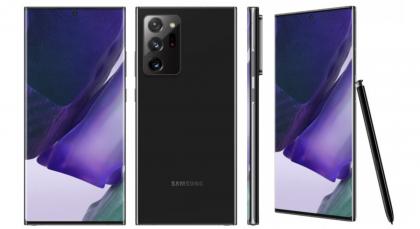Samsung Electronics may not adopt QD-OLEDs for its TVs, SDC looking for other customers
In October 2019 Samsung Display formally announced its decision to invest $10.85 billion in QD-OLED TV R&D and production lines. The company is already starting to produce prototypes, and is on track to start mass production in Q3 2021.

But SDC is facing a problem it probably did not anticipate - Samsung Electronics is hesitant about the adoption of QD-OLED panels, and may not ship QD-OLEDs in 2021 - or maybe even at all. Apparently Samsung Electronics wants to focus on microLEDs for next-generation displays as it finds QD-OLED TVs to be not bright enough - and also because it suffers from burn-in issues.
Samsung Display announces a 1.4R foldable OLED display
Samsung Display announced that it has commercialized a new foldable OLED display that is the first to achieve a curvature radius of 1.4R mm. This display will be adopted in Samsung's Galaxy Z Fold2 5G (7.6" 1768x2208 HDR10+ 120Hz Dynamic AMOLED) with an Ultra-Thin Glass (UTG) cover glass.

Samsung says that in order to minimize the folding stress that is increased in such a small folding radius, the company has optimized a series of technologies related to the material of the display, the panel design and the module assembly, so that the multi-layered structure will function like a cushion when the panel is folded.
Samsung may be forced to stop supplying OLEDs to Huawei due to US sanctions
The US government imposed sanctions against Huawei, which prevents the Chinese company to acquire components that use US-developed chips. According to a report from Korea, both Samsung Display and LG Display will have to stop supplying OLED displays to Huawei as these use drivers that are based on US-developed technology.

Samsung Display has applied for a US US Department of Commerce license which will allow it to export the technology to Huawei. LG Display decided not to apply for the license, at least for now, as its OLED sales to Huawei are limited in any case.
Is Xiaomi developing a transparent OLED monitor in collaboration with Samsung?
In an interesting report from China, it is claimed that Xiaomi is developing a 27-inch transparent OLED monitor, based on panels supplied by Samsung Display. According to the rpeort Xiaomi plans to release this display by 2021.

Last month Xiaomi announced the world's first "consumer" transparent OLED TV, the Xiaomi Mi TV LUX Transparent Edition that features a 55" 120Hz 120Hz WOLED TV panel. The Mi TV Lux is now shipping in China for 49,999 yuan (around $7,200).
Samsung Electronics collaborates with Corning on Ultra Thin Glass technology for foldable OLEDs
Samsung started to adopt ultra-thin glass covers for its foldable AMOLEDs, instead of polyimide, as it says UTG offers higher durability. In the Galaxy Z Flip, Samsung used a UTG cover produced by Korea-based Dowoo Insys, who processes Schott's ultra thin glass for Samsung Display.

In April 2020 it was reported that Samsung Electronics wants to develop its own UTG cover technology, as as it feels that Samsung Display's UTG is still not robust enough and the company also wants to increase production yields and reduce costs. Now there are new reports from Korea that say that Samsung Electronics is collaborating with Corning in this new UTG project.
UBI: rigid OLED smartphone shipments dropped by 40% in Q2 2020
UBI Research estimates that OLED smartphone display shipments reached 87 million units in Q2 2020 (down 23.1% compared to Q2 2019, and down 17% compared to Q1 2020).

The drop in rigid OLED smartphone display shipments was 40.3% from Q2 2019 to Q2 2020 - due to a drop in mid-tier smartphone production in China. Flexible OLED shipments actually rose 38% from last year as you can see in the chart below.
Samsung starts to ship QD-OLED TV prototypes to potential customers, may produce QD-OLED gaming monitors
According to Omdia, Samsung Display has started to provide QD-OLED TV prototypes to potential customers - including Samsung Electronics, Sony and Panasonic. Samsung Display is on track to start mass production in Q3 2021.

Interestingly, Samsung Electronics is still not sure whether it will adopt QD-OLED TVs in 2021, as the company aims to focus on mini-LED panels in 2021, and may only release QD-OLED TVs in 2022.
DisplayMate: the Samsung Galaxy Note 20 Ultra has the best AMOLED display ever
Samsung recently announced the Galaxy Note 20 Ultra smartphone, with a 6.9-inch 1440x3088 Dynamic AMOLED with an LTPO backplane. The display supports a refresh rate of 120Hz at Full-HD resolution and 60Hz at QHD. The Galaxy Note family will ship on August 21 2020.

The display measurements experts at DisplayMate tested a Note 20 Ultra phone, and reports that Samsung again improved its OLED display performance (it "raises the bar significantly higher", in fact) and this high performance display will be the competitive baseline for all upcoming smartphone displays.
Samsung announces a new variable refresh rate technology for its latest AMOLED displays
Samsung Display announced a new OLED technology, called Adaptive Frequency that enables variable refresh rate in AMOLED displays - ranging from 10Hz to 120Hz. Running OLEDs at low refresh rates when possible can reduce the power consumption of the display (over all applications) by up to 22%.

This new display technology was applied for the first time in the Galaxy Note20 Ultra 5G smartphone, announced earlier this month, with its 6.9-inch 1440x3088 Dynamic AMOLED.
Samsung researchers arrested for allegedly leaking OLED technology to a Chinese company
A report from Korea updates that three Samsung Display researchers in Suwon were arrested for allegedly leaking OLED technology. Directors of a Chinese company subsidiary were also arrested in this case

According to the report, the technology that was leaked relates to optical alignment of inkjet printing processes. Samsung reportedly invested over 10 billion won ($8.5 million) in developing this technology.
Pagination
- Previous page
- Page 35
- Next page

